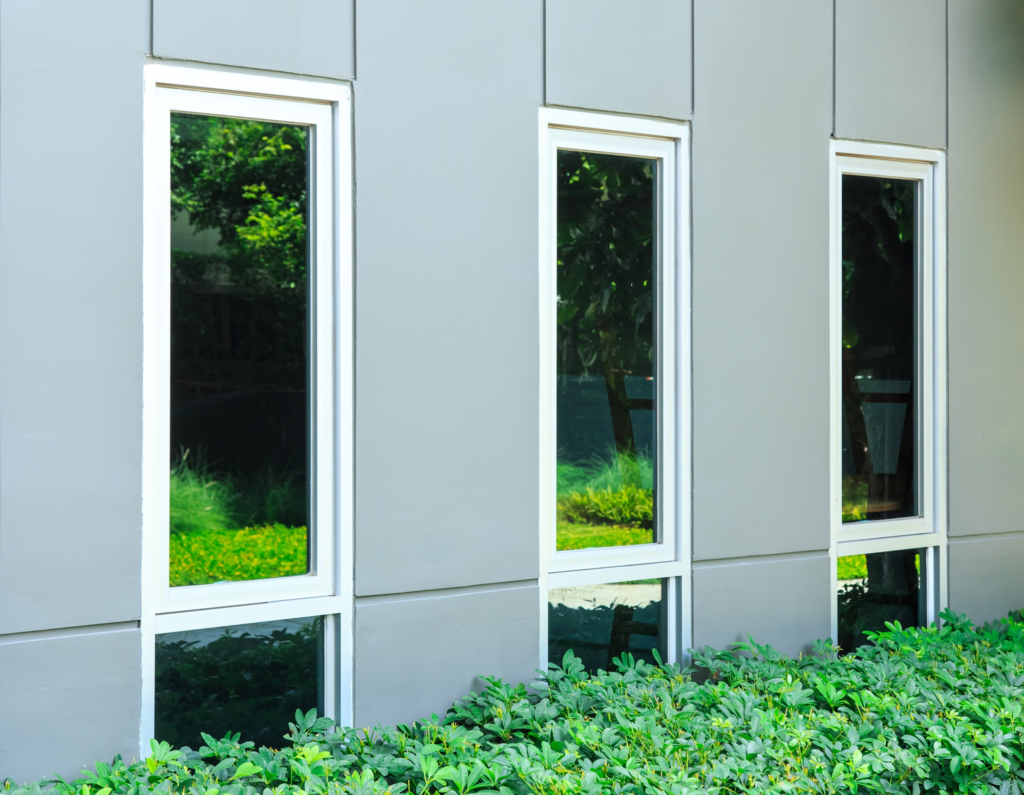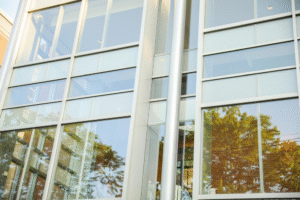
Traditional windows and doors waste energy, increase costs, and fail to meet modern sustainability expectations. Eco-friendly windows and doors, on the other hand, offer innovative solutions that enhance energy efficiency, reduce environmental impact, and align with green building standards.
Why settle for outdated options when these sustainable alternatives can transform your projects?
Choosing eco-friendly windows and doors is an effective way to reduce environmental impact, enhance energy efficiency, and achieve a balance between aesthetics and functionality.
Integrating sustainable materials into projects is a strategic advantage. It meets growing market demand for energy-efficient buildings, reduces long-term operational costs, and adds value to properties.
This article explores the key benefits, materials, and technologies that make sustainable windows and doors the ideal choice for modern construction. Let’s dive in!
Why eco-friendly windows and doors matter
Buildings account for nearly 30% of global energy consumption, and traditional windows and doors could be one of the major sources of energy waste.
To change this scenario, the construction industry is undergoing a major shift toward green building, driven by stricter regulations and the need for more energy-efficient structures.
Eco-friendly alternatives are essential in reducing emissions, optimizing insulation, and enhancing the sustainability of commercial and residential projects.
Green Building
Green building is the practice of designing, constructing, and operating buildings in an environmentally responsible and resource-efficient way. This approach considers the entire structure lifecycle to minimize environmental impact and maximize energy efficiency.
Key green building principles include:
- Efficient energy use: Optimizing insulation, reducing heat loss, and integrating passive design strategies.
- Sustainable materials: Using recyclable materials such as reclaimed wood.
- Improved indoor environmental quality: Enhancing air circulation, natural lighting, and thermal comfort for occupants.
Architects and developers can maintain compliance with modern sustainability benchmarks, such as LEED and Energy Star standards, by incorporating eco-friendly windows and doors into their projects.
The environmental impact of traditional materials
Many conventional materials contribute to excessive energy waste and environmental degradation. For example:
- Single-pane glass allows heat to escape in winter and overheat interiors in summer, increasing HVAC use.
- Non-recyclable PVC and untreated wood contribute to deforestation and plastic pollution.
- Standard aluminum production generates high CO₂ emissions due to energy-intensive manufacturing.
In contrast, eco-friendly windows and doors utilize sustainable materials, advanced glazing technologies, and thermally efficient frames, reducing energy demand and supporting green building initiatives.
Why green building certifications are driving change
As businesses and governments push for greener construction standards, major certifications are shaping industry requirements:
- LEED (Leadership in Energy and Environmental Design) – Recognizes sustainable buildings that optimize energy efficiency and resource conservation.
- Energy Star Certification – Ensures that windows and doors meet strict performance criteria for energy savings.
- Passive House Standards – Focuses on airtight, highly insulated windows and doors to maintain optimal indoor climates.
Green building is an industry standard. You can future-proof your projects, comply with evolving regulations, and contribute to a more sustainable built environment.
Up next, we’ll explore the best sustainable materials for windows and doors and how they enhance energy efficiency and environmental responsibility.
Sustainable materials for eco-friendly windows and doors

As green building practices become the industry standard, selecting the right materials is essential for maximizing sustainability, durability, and performance.
Eco-friendly windows and doors contribute to energy conservation, resource efficiency, and long-term cost savings. Below, we explore the best sustainable materials for windows and doors, their benefits, and how they align with green building standards.
Recycled aluminum
Aluminum is one of the most recyclable materials in construction, with its original material being reusable without losing quality.
Unlike traditional aluminum, which requires high energy consumption for production, recycled aluminum reduces carbon emissions and supports circular economy practices.
Why choose recycled aluminum?
- Resistant to corrosion, guaranteeing long-term performance.
- When paired with thermally broken frames, it enhances insulation and reduces heat transfer.
- Requires 95% less energy to produce compared to primary aluminum.
FSC-Certified Wood
Wood is a biodegradable and renewable resource, but not all wood is sustainable. FSC-certified wood (Forest Stewardship Council) ensures the material comes from responsibly managed forests with minimal environmental impact.
Why choose FSC-certified wood?
- Provides excellent thermal efficiency, reducing heating and cooling needs.
- Unlike synthetic materials, wood stores carbon rather than emitting it.
- Combines sustainability with warm and natural design aesthetics.
Recycled PVC or Eco-friendly PVC
Traditional PVC (polyvinyl chloride) is criticized for its environmental impact, but recent advancements have introduced low-impact and recycled PVC options that reduce waste and chemical emissions.
Why choose Recycled PVC or Eco-friendly PVC?
- Many manufacturers now offer closed-loop recycling systems for PVC frames.
- Highly resistant to moisture and rot, making it a low-maintenance option.
- Reduces thermal bridging, improving overall energy efficiency.
High-Performance Glass
Glass selection is essential when designing eco-friendly windows and doors. This feature impacts thermal performance, energy savings, and indoor comfort. Double and triple-glazed windows reduce heat transfer and lower energy costs.
Why choose energy-efficient glass?
- Two layers of glass with an argon gas fill reduce heat loss and enhance insulation.
- Adds an extra layer for maximum thermal efficiency, ideal for extreme climates.
Why sustainable materials matter
Using eco-friendly windows and doors made from recycled aluminum, FSC-certified wood, Recycled PVC or Eco-friendly PVC, and high-performance glass will guarantee compliance with green building certifications.
Now, let’s explore the latest innovations in sustainable window and door technologies that are transforming the construction industry.
Sustainable technologies and innovations in eco-friendly windows and doors
The summer of 2024 was the hottest on record globally, underscoring the urgent need for energy-efficient, climate-resilient buildings. According to the U.S. Department of Energy, windows alone contribute to 43% of a building’s heat gain or loss, making them a target for efficiency improvements.
Fortunately, advancements in eco-friendly windows and doors are revolutionizing the construction industry. From Low-E coatings and smart sensors to solar-integrated glass, these innovations are making buildings more energy-efficient, cost-effective, and environmentally responsible.
Low-Emissivity (Low-E) Glass
Low-emissivity (Low-E) coatings have been a game-changer in window technology since their introduction in the 1980s. These microscopically thin metallic coatings reflect infrared heat, improving energy efficiency.
Why low-e glass matters:
- Reduces reliance on HVAC systems by maintaining stable indoor temperatures.
- Minimizes interior fading while maintaining daylight access.
- Supports LEED and Energy Star certifications by reducing energy waste.
Smart sensors and automated shading
Integrated sensors and automated shading systems adjust based on real-time environmental conditions, reducing solar heat gain and unnecessary energy use.
How smart sensors improve efficiency in eco-friendly windows and doors
- Window blinds and electrochromic glass adapt to sunlight exposure, minimizing overheating.
- Smart windows open and close automatically to optimize indoor air circulation.
- Integrated systems track real-time energy consumption, allowing for more efficient energy management.
Solar windows
The next frontier in eco-friendly windows and doors is photovoltaic (PV) glass, which incorporates transparent solar cells that convert sunlight into electricity.
Why solar windows are a game-changer
- Reduces reliance on the power grid.
- Supports net-zero building initiatives.
- Provides clean energy without compromising design or visibility.
The future of sustainable windows and doors
As climate change accelerates, the demand for eco-friendly windows and doors will continue to grow. With rising temperatures, stricter building codes, and increasing energy costs, the industry must embrace cost-effective innovations to reduce energy consumption.
How to choose eco-friendly windows and doors for your projects

This section provides a practical checklist to help construction professionals and designers select eco-friendly windows and doors decisions that align with green building standards.
Step-by-step checklist for selecting eco-friendly windows and doors
Assess energy performance ratings
Check the U-factor: A lower U-factor means better insulation. Look for ≤ 0.30 for optimal thermal efficiency.
Verify the visible transmittance (VT): Ensure adequate natural light penetration to reduce reliance on artificial lighting.
Check for argon/krypton gas fills: These gases improve insulation in multi-pane windows.
Choose the right sustainable materials
- Recycled aluminum: Look for suppliers that use at least 75% recycled aluminum to lower carbon footprint.
- FSC-certified wood: Verify if the wood is certified by the Forest Stewardship Council (FSC) to guarantee responsible sourcing.
- Recyclable or Eco-friendly PVC: Opt for phthalate-free, recyclable PVC to balance durability and sustainability.
- Triple or quad-pane glass: For extreme climates, choose high-performance glazing to reduce energy consumption by up to 50%.
Verify energy and sustainability certifications
- LEED (Leadership in Energy and Environmental Design): Does the window or door contribute to LEED points for energy efficiency?
- Energy Star Certification: Ensure compliance with the latest Energy Star 7.0 efficiency ratings.
- Passive House Standard: If designing a passive house, look for ultra-high thermal efficiency ratings.
Evaluate durability and climate suitability
- Consider climate zones: Choose eco-friendly windows and doors suited to your region’s energy code requirements.
- Test for weather resistance: Look for products with high wind, water, and air infiltration ratings.
- Confirm longevity: Opt for warranties of 20+ years to maximize product durability and long-term cost savings.
- Ensure low-maintenance design: Choose finishes that resist moisture, UV exposure, and wear.
Ask the right questions to suppliers
- Where are the materials sourced?
- What is the embodied carbon footprint?
- Can the windows/doors be disassembled for recycling?
- How does your warranty compare to industry standards?
Consider smart and high-performance features
- Low-E glass coatings: Reduces heat gain and glare while allowing natural light to enter.
- Vacuum-insulated or aerogel glass: For the highest efficiency in extreme climates.
- Smart sensors for automated ventilation: Windows that open/close based on temperature and CO₂ levels.
- Photovoltaic glass (Solar Windows): Generates renewable solar energy while functioning as a window.
Integrate sustainability into project design
- Optimize window placement: Position windows to maximize daylight and passive solar heating.
- Pair with energy-efficient frames: Choose thermally broken aluminum or composite frames for better insulation.
- Combine with shading strategies: Use overhangs or electrochromic glass to prevent overheating.
- Ensure proper installation: Even the most efficient windows will fail if poorly installed—work with certified professionals.
Choosing eco-friendly windows and doors requires a holistic approach. By following this checklist, you can be certain that your projects meet green building standards, reduce environmental impact, and enhance energy efficiency.
Eco-friendly windows and doors are a smart investment
Now that you know everything about this topic and have a practical checklist in hand, it’s time to take the next step. But before you do, let’s quickly recap the key benefits of eco-friendly windows and doors:
- Lower operating costs: High-performance insulation reduces energy consumption, cutting heating and cooling expenses.
- Improved indoor comfort: Superior thermal regulation maintains a stable indoor temperature for the entire year.
- Enhanced acoustic insulation: Noise reduction technology creates a quieter, more comfortable living and working environment.
- Increased property value: Sustainable buildings attract buyers and tenants, boosting real estate marketability.
- Regulatory compliance: Meets modern energy efficiency standards such as LEED, Energy Star, and Passive House.
- Environmental impact reduction: Low-carbon materials and energy-efficient designs help decrease the building’s ecological footprint.
With stricter regulations and rising demand for green-certified buildings, now is the time to make the switch.
Discover how Top Notch Remodeling can help you integrate high-performance, eco-friendly windows and doors into your next project. Contact us today to explore customized solutions that meet your sustainability goals!



